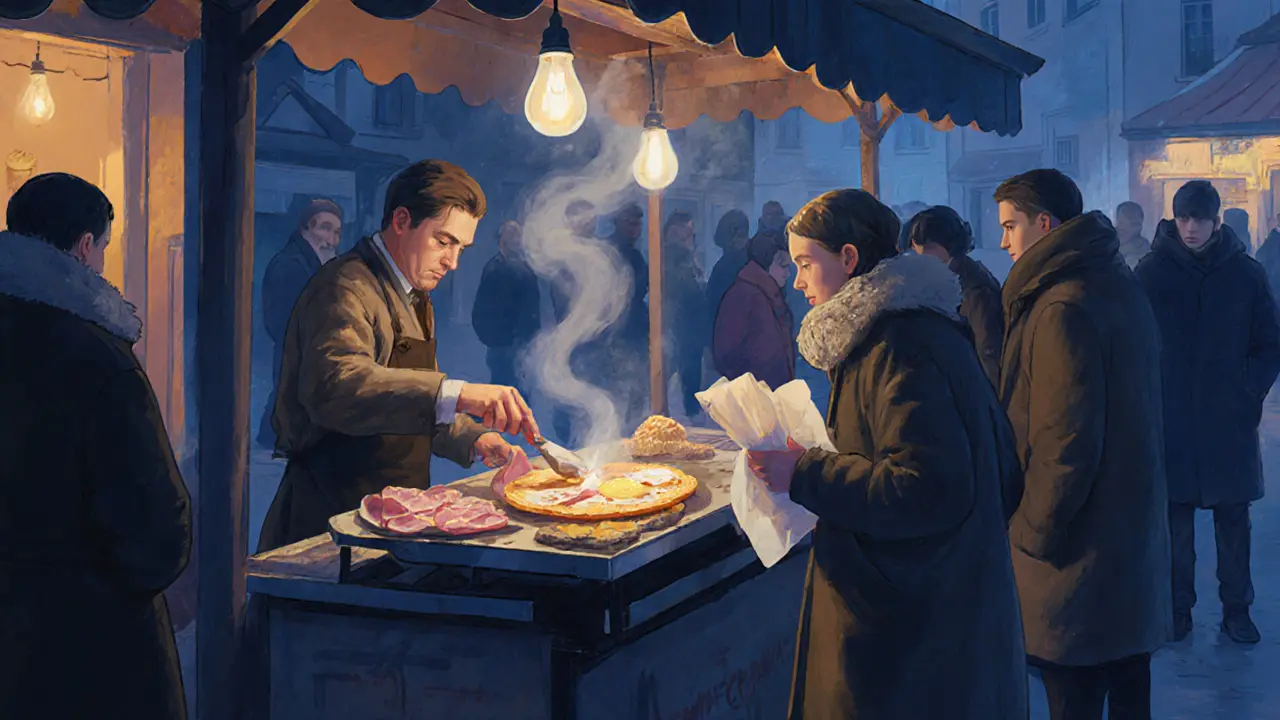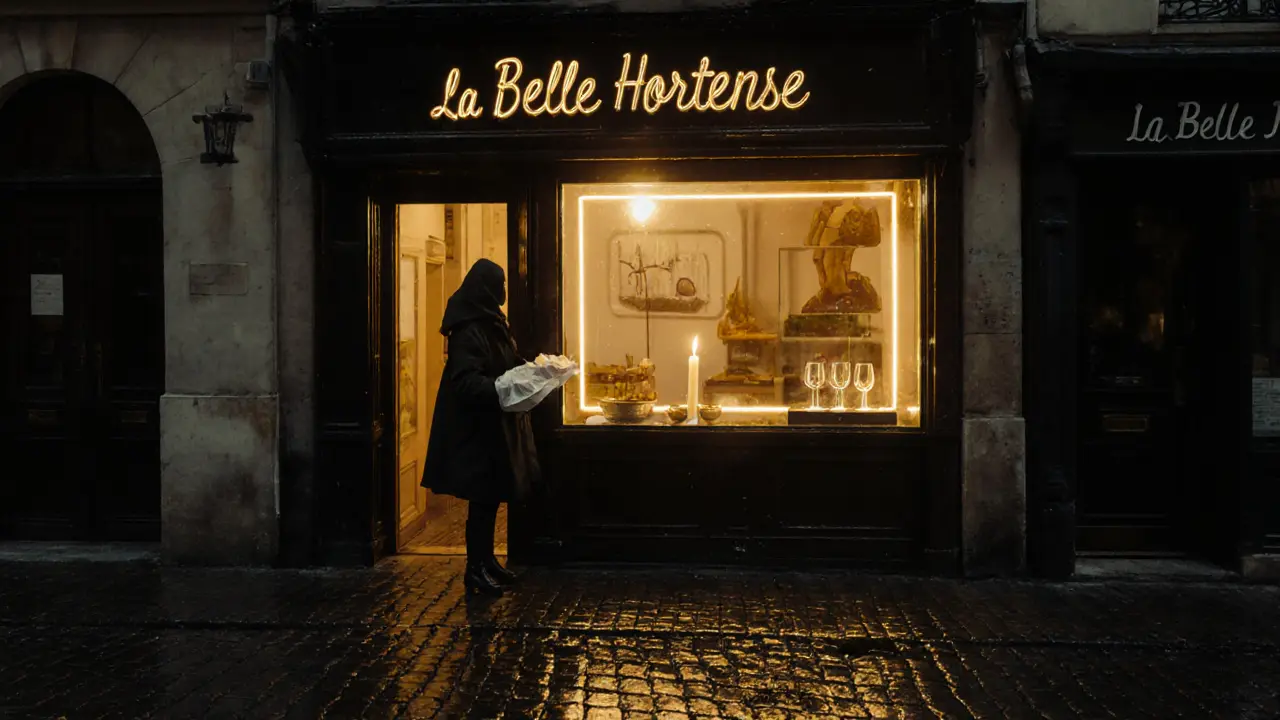Paris doesn’t sleep-it just changes menus.
Most visitors see Paris in daylight: the Eiffel Tower glittering, cafés buzzing with morning espresso, street artists lining the Seine. But the real soul of the city wakes up after 10 p.m. That’s when the boulangeries close, the wine bars open wider, and the kitchens of hidden Paris food at night spots start humming with the rhythm of late-night hunger.
This isn’t about clubs or tourist traps. This is about the quiet corners where locals eat, the chefs who work past midnight, and the meals that taste different under streetlamp glow. You don’t need a reservation. You just need to know where to walk.
Where the locals eat after midnight
When the museums shut and the tourists head back to their hotels, Parisians head to places like Le Comptoir du Relais in Saint-Germain. It’s tiny. No sign. Just a counter, a chalkboard menu, and a line of people who know better than to ask for a menu. Order the duck confit. It’s been cooked slow for 12 hours. They serve it with crispy potatoes and a glass of natural wine-no corkage fee, no pretense.
Down in the 13th arrondissement, Le Baratin has been serving rustic French food since 1996. The chef, a former butcher, still makes his own charcuterie. The wine list? Handwritten. The chairs? Wobbly. The lamb stew? Worth every step of the walk from Place d’Italie. It’s open until 2 a.m. on weekends. You’ll see nurses, artists, and taxi drivers eating side by side.
These aren’t restaurants. They’re rituals.
The bistro that never closes
Not every late-night spot needs a reservation or a Michelin star. Some just need to be open when the rest of the city is quiet.
La Belle Hortense in the Marais has been open 24 hours since 2007. It started as a wine bar for night-shift workers. Now, it’s a refuge for anyone who needs warm food at 3 a.m. The menu hasn’t changed in 18 years: croque-monsieur, onion soup, a simple grilled sardine. The owner, Claudine, still pours the wine herself. She remembers your name if you come twice. She doesn’t care if you’re drunk, tired, or lost. She just asks: "Tu veux quoi?"-What do you want?
There’s no Wi-Fi. No Instagrammable plating. Just a plate of food, a glass of Beaujolais, and the quiet clink of cutlery against ceramic.
Midnight snacks in the market alleys
Paris has over 90 covered markets. Most close by 7 p.m. But not all.
At Marché d’Aligre, the last stall to shut down is the one selling crêpes salées. It’s run by a Breton family who’s been there since 1982. At midnight, they’re flipping buckwheat pancakes with ham, gruyère, and a fried egg. You eat them standing up, wrapped in parchment paper, steam rising in the cold air. It costs €4.50. You’ll remember it longer than any five-star dinner.
Same thing at Marché des Enfants Rouges in the 3rd. The Moroccan stall owner, Karim, stays open until 1 a.m. on Fridays and Saturdays. His lamb tagine with prunes and almonds is slow-cooked in a clay pot. He serves it with warm flatbread. No fork needed. Just your fingers and a napkin.

Wine bars that turn into kitchens
Parisian wine bars don’t just pour. They plate.
Le Verre Volé in the 11th arrondissement started as a small shop selling natural wines by the bottle. Now, they serve small plates after 9 p.m. Think: roasted beets with goat cheese and hazelnuts, or duck liver mousse on toasted sourdough. The wine list changes weekly. The staff will ask what you’re craving-and match you with a wine you’ve never heard of. They don’t have a website. You find them by walking down Rue de la Roquette and following the smell of garlic and roasting thyme.
At La Buvette, tucked under the train tracks in the 10th, the menu is written on a blackboard that changes every night. One week: grilled sardines with lemon and olive oil. The next: chicken liver parfait with pickled cherries. They don’t take reservations. You wait. You chat. You drink a glass of orange wine. And when your name is called, you sit down and eat like you’ve been waiting all day.
The secret of the Parisian sandwich
Forget the croissant. The real Parisian late-night staple? The pan bagnat.
It’s not fancy. It’s a round, crusty bread, split open and stuffed with tuna, hard-boiled eggs, olives, tomatoes, and anchovies. It’s soaked in olive oil and vinegar. It’s messy. It’s cold. It’s perfect.
You’ll find it at Le Petit Cler in the 7th. The owner, Marc, makes them from 11 p.m. to 4 a.m. He uses tuna from the south of France. The olives are from Nyons. He doesn’t charge extra for anchovies. You just say yes or no. He’ll wrap it in wax paper and hand it to you like it’s the most normal thing in the world.
People line up for it. Not because it’s trendy. But because it’s the only thing that fixes a bad night.
What to drink when the bars get loud
Paris isn’t about cocktails. Not really.
At midnight, the best thing to sip is a glass of vin naturel-natural wine. It’s made without added sulfites or yeast. It tastes alive. Slightly fizzy. Sometimes a little funky. But always real.
Try it at Le Baron Rouge in the 10th. The barkeep, Sophie, pours wines from small farms in the Loire Valley. She’ll tell you the name of the grower. The altitude. The soil type. She doesn’t care if you know the difference between Gamay and Pinot Noir. She just wants you to taste it.
Or go to Le Chateaubriand in the 11th. They serve wine by the glass-but only if you order food. Their signature dish? A single piece of grilled beef with sea salt. You eat it slowly. You drink slowly. You don’t rush. Because in Paris, the night isn’t something to burn through. It’s something to savor.

When the city wakes up again
By 5 a.m., the last wine glasses are drained. The last crêpes are folded. The last sandwiches are wrapped.
But the city doesn’t end. It just shifts.
At dawn, the boulangeries open. The smell of fresh baguettes fills the streets. The café owners turn on the lights. The night workers head home. And the people who stayed up-those who ate at 2 a.m. in a tiny kitchen, who drank wine with strangers, who bit into a sandwich and didn’t care who saw them-know the truth.
Paris isn’t about the landmarks. It’s about the meals you eat when no one’s watching.
What to do if you’re hungry after midnight
- Walk toward the 10th, 11th, or 13th arrondissements. That’s where the real late-night spots live.
- Don’t look for signs. Look for people standing outside, eating with their hands.
- Order the house special. It’s always the best thing on the menu.
- Ask for a glass of natural wine. It’s cheaper than a cocktail and tastes better.
- Bring cash. Most places don’t take cards after midnight.
- Be quiet. This isn’t a party. It’s a pause.
What to avoid
- Tourist-heavy areas like Montmartre or Champs-Élysées after 10 p.m.-they’re either closed or overpriced.
- Restaurants with English menus and neon signs. They’re not for locals.
- Trying to book a table after 11 p.m. Most places don’t take reservations past that hour.
- Expecting quiet. Paris at night is alive. But it’s not loud. It’s warm.
Can I find good food in Paris after midnight?
Yes, but not where you expect. The best late-night eats are in neighborhood bistros, market stalls, and wine bars that stay open past 1 a.m. Places like Le Comptoir du Relais, La Belle Hortense, and Le Baratin serve real food-no tourist menus, no plastic-wrapped meals. You just need to know where to walk.
Is Paris nightlife safe at night?
Generally, yes. The areas where people eat late-like the 10th, 11th, and 13th arrondissements-are well-lit and busy with locals. Avoid empty streets near the Seine after 2 a.m. Stick to places where people are eating, not just drinking. If a place has a line, it’s safe.
Do I need to speak French to eat at these places?
Not at all. Most servers speak basic English. But if you learn two phrases-"Je voudrais..." (I would like...) and "Merci" (Thank you)-you’ll get better service. The real key? Smile. Point. Nod. Parisians appreciate effort more than fluency.
What’s the best late-night snack in Paris?
The pan bagnat. It’s a cold sandwich made with crusty bread, tuna, hard-boiled eggs, olives, tomatoes, and anchovies. It’s messy, salty, and perfect after a long night. Find it at Le Petit Cler in the 7th-it’s open until 4 a.m.
Are there vegetarian options for late-night eating in Paris?
Yes. Many spots offer vegetable tarts, grilled cheese, roasted beets with goat cheese, or lentil salads. At Le Verre Volé and La Buvette, the menu changes daily and always includes at least one vegetarian option. The market stalls at Marché d’Aligre also serve warm vegetable crêpes and grilled vegetables on bread.
Next steps: Where to go next
If you loved this guide, try walking the same route at dawn. The boulangeries open at 5 a.m. The city smells like yeast and rain. The same people who ate crêpes at 2 a.m. are now buying baguettes. Paris doesn’t change-it just turns the page.
